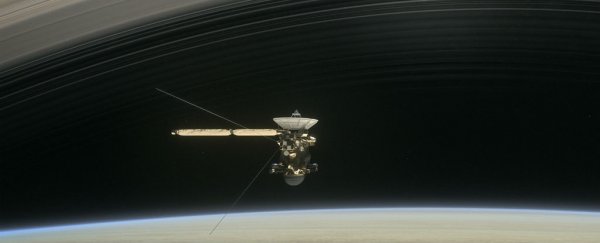If you happen to have an irrational fear of one day getting sucked out into space to die a lonely, silent death in the sad, black void of the Universe… strap in, because it's time to experience your nightmares in audio form.
NASA's Cassini spacecraft just sent back the first ever sounds of the space inside Saturn's rings, and while they're not quite as spooky as the bizarre sounds that waft around Jupiter, just remember - this is what near-total emptiness sounds like.
The sound files were delivered ahead of today's leg of Cassini's 'grand finale', which saw it bounce into the gap between Saturn and its rings for the second time just hours ago.
Cassini's initial dive into Saturn's ring-bound void was on April 26th, when it first recorded these sounds.
Not only is this the first time that we've been able to 'hear' what this unique section of space sounds like, it's the first time that a spacecraft has ever ventured into the gap between Saturn and its rings.
Scientists were surprised to see just how empty it was.
"The region between the rings and Saturn is 'the big empty', apparently," says Cassini project manager Earl Maize of NASA's Jet Propulsion Laboratory in Pasadena, California.
"Cassini will stay the course, while the scientists work on the mystery of why the dust level is much lower than expected."
Here are the two recordings, which, apart from the constant static, give you an idea of just how little there is skirting the second closest gas planet to Earth:
As NASA explains in a statement, when Cassini was passing through Saturn's rings, its Radio and Plasma Wave Science (RPWS) instrument detected hundreds of 'ring particles' as expected, but once it hit the gap, things got strangely quiet.
"RPWS detected the hits of hundreds of ring particles per second when it crossed the ring plane just outside of Saturn's main rings, but only detected a few pings on April 26," NASA says.
To be clear, RPWS doesn't directly record sound waves like a tape recorder - this isn't what we'd hear with our own ears (if we ever found ourselves floating through that part of the Solar System). Instead it detects radio and plasma waves, which are then converted into sound.
The result is that we can 'hear' dust particles hitting the instrument's antennas like pops and cracks, which contrast with the usual whistles and squeaks generated by the charged particle environment of space.
"The RPWS team expected to hear a lot of pops and cracks on crossing the ring plane inside the gap, but instead, the whistles and squeaks came through surprisingly clearly on April 26," says NASA.
Instead of hearing the expected particles whizzing by, scientists say they've only been able to detect very few particles - and those they did find were no larger than smoke particles.
"It was a bit disorienting - we weren't hearing what we expected to hear," adds William Kurth, RPWS team lead at the University of Iowa.
"I've listened to our data from the first dive several times and I can probably count on my hands the number of dust particle impacts I hear."
This isn't the first time we've gotten an eerie audio postcard from a neighbouring planet's outskirts.
Back in 2016, NASA's Juno spacecraft recorded the haunting sounds near Jupiter as it approached the gas giant:

The good news is that even though Saturn's 'big empty' has puzzled scientists, we've got a whole lot more exploring to do, with 20 more dives scheduled for the coming weeks.
In September, Cassini's last dive will see it plummet into Saturn itself to be burned up in the planet's atmosphere.
You can bet we're going to see a whole lot more cool stuff before then.
